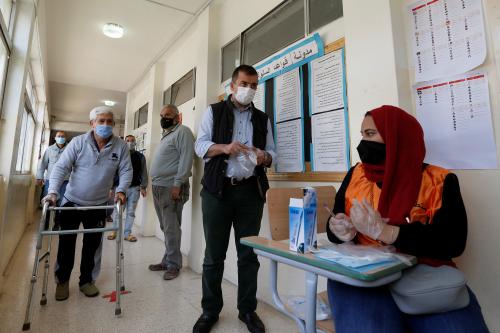

2:00 am +04 - 3:00 am +04
Past Event
Content from the Brookings Doha Center is now archived. In September 2021, after 14 years of impactful partnership, Brookings and the Brookings Doha Center announced that they were ending their affiliation. The Brookings Doha Center is now the Middle East Council on Global Affairs, a separate public policy institution based in Qatar.
Ibrahim Fraihat, senior fellow in foreign policy at the Brookings Doha Center and an adjunct assistant professor at Georgetown University in Qatar, delivered a CIRS Monthly Dialogue lecture on “Managing the Saudi-Iranian Rivalry” on October 27, 2015. With a background in conflict resolution, Fraihat offered an analysis of how to reduce tensions in the Middle East region using two different approaches.
The first approach offered by Fraihat isolates individual conflicts as an exclusive case requiring specific solutions targeted at particular nations. The second approach takes a more regional stance, and perceives of Middle East conflicts as somewhat interrelated. This approach posits that many of the current conflicts, including those in Yemen and Syria, are the result of proxy wars, and are linked, in one way or another, to larger regional rivalries. Fraihat argued that the second approach was more useful in its holistic view of regional conflicts being the result of spillover tensions generated elsewhere.
He explained that “most, if not all, of the conflicts in the region are linked in one way or another to Tehran and Riyadh, or to the Saudi-Iranian relationship…If you are able to reduce the tension, or achieve some rapprochement between Saudi Arabia and Iran, then by the time you bring them to the table to sit and talk and have some understanding, then probably 50 percent of the conflicts will disappear.”
Fraihat gave a complex characterization and background to the history of the Saudi-Iranian rivalry, arguing that there have been peaks of hostility related to specific regional incidences over the years. Leaving aside the legacy of a centuries-old Arab-Persian enmity, more recent regional concerns were stoked with the onset of Iran’s 1979 Islamic revolution and the rise of a rival political and Islamic power prepared to challenge Saudi regional hegemony. Concerns about Iranian dominance led Saudi Arabia to support Iraq in its war against Iran in the 1980s. A further escalation of antagonisms began in the aftermath of the 2003 US invasion of Iraq, which, effectively, changed the regional order, and led to a power vacuum in which Saudi Arabia and Iran vied for geopolitical influence. There was a new and sour turning point in the Saudi-Iranian relationship during the events of the 2011 Arab uprisings that fueled the conflict in Syria, further increasing regional tensions.
A central question about the Saudi-Iranian rivalry, and especially one asked from the perspective of the Western media, is whether or not the conflict is sectarian in nature. While sectarianism has been used to fan the flames of the rivalry, and to advance certain agendas, this is an over-simplification that only serves to reduce a longstanding antagonism into a simple sectarian binary. Importantly, the fraught Saudi-Iranian relationship has evolved over the years for a number of different reasons, including those related to national interests, economic development, and gains in geopolitical power, but not all can be properly identified or agreed upon by scholars, analysts, and policymakers. There is a variation of views and opinions on both sides, making the rivalry difficult to manage. “Even within the parties themselves, there is no clear understanding about what the conflict is really about,” Fraihat argued.
The two regional giants tend to take two distinct positions on regional issues, as seen in the cases of Yemen and Syria. However, despite the many instances of opposition, Fraihat argued, there is a surprising amount of overlap between Iran and Saudi Arabia’s mutual needs, especially as they relate to security interests and environmental concerns. “Don’t be led, or misled actually, by the obvious positions of the two countries,” he said.
Fraihat gave several strategies for addressing the finer points of the rivalry, including mediation, dialogue, confidence-building measures, credible peace plans, zones of peace, developing areas of interdependence, and restoring the balance of power. “At the end of the day,” he said, “there is no alternative to the parties talking,” and this is the key first step to mediating any rivalry. Switzerland, Norway, and Qatar have a history of mediation, and they could act as effective hosts for any potential negotiations. This would mean, however, that Saudi Arabia and Iran must be willing to engage with each other in a serious manner.
Another opportunity for mediation is the intervention of a powerful third party. Turkey, the United States, and Pakistan all play a role in the region in one way or another. In addition, Fraihat said, “Iraq here has a huge role to play in minimizing and reducing the tension and contributing to better management of the conflict.” This can only occur if the implicated powers agree to build a free, independent, and democratic Iraq.
In conclusion, Fraihat argued that, when it comes to solving regional tensions, analysts tend to talk about official “track 1” solutions between governments, but the potential of building peace between the two countries can also be advanced with “track 2” diplomacy—unofficial dialogue between influential societal figures like academics and religious leaders to build relationships and encourage new thinking that can inform policymakers. Finally, a conducive “track 3” approach is to encourage citizens of Saudi Arabia and Iran to engage with each other at the grassroots and communal level, which is another approach that could lead to a sustainable peace between the two countries.
This event summary was originally published by Georgetown University’s Center for International and Regional Studies.

Noha Aboueldahab
August 23, 2021

August 23, 2021

Yasmina Abouzzohour
August 19, 2021